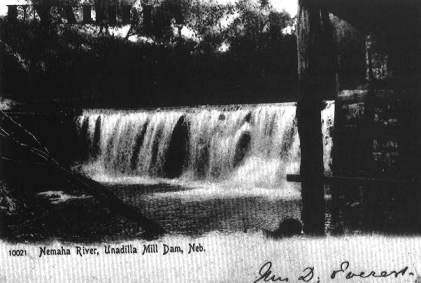 UNADILLA -- OTOE COUNTY UNADILLA -- OTOE COUNTY
When looking at all the towns platted in Otoe County
during
the 1860s, it is a wonder that Unadilla has survived.
Paisley, to
the west, and Nursery Hill, to the east, met their
demise before
the turn of the century.
In 1864 James Wallen and his family claimed the 24th
homestead
in the county and established a "half-way house" which
served freighters on the Nebraska City cut-off route.
It was
immortalized under another name in the novel "Nebraska
Coast" by Clyde Brion Davis.
Strite and Catherine Axtell, having "inside
information" on the path of the railroad, platted and
recorded a town in May 1871. Mrs. Axtell is said to
have borrowed
the name from Unadilla, New York. "Unadilla" is an
Iroquois Indian word meaning "a place of meeting."
William Saunders built the first house, which was on
the site now
occupied by Lempka Recycling. Almost due south, on the
bank of
the Little Nemaha, Saunders built a dam to provide
power for the
Unadilla Roller Mills.
The school district was organized in 1871, with
classes held
in a building near the town site. A school was built
in 1872 near
where the Methodist Church now stands.
The Missouri Pacific Railroad tracks entered Unadilla
approximately 1,000 feet south of the Saunders'
residence.
Crossing the south road, it makes a wide curve and
exits the town
in a north westerly direction. Following the grade of
the tracks,
main street was also laid out along the curved line.
 A
post office was established in April, 1872, as
were two small general stores, and a blacksmith shop.
However,
while there was a siding at this location, no depot
was built. A
depression, which gripped the nation in 1873, made for
"tight money" all along the new line. In 1874 the
people collected what they could and built their own
depot and a
stockyard, which they donated to the railroad. It soon
became
known for "top prices" for cattle and grain. An
elevator was built in 1880, which handled 90,000
bushels of grain
the following year. Large amounts of stone from a
nearby quarry
were also shipped by rail. A
post office was established in April, 1872, as
were two small general stores, and a blacksmith shop.
However,
while there was a siding at this location, no depot
was built. A
depression, which gripped the nation in 1873, made for
"tight money" all along the new line. In 1874 the
people collected what they could and built their own
depot and a
stockyard, which they donated to the railroad. It soon
became
known for "top prices" for cattle and grain. An
elevator was built in 1880, which handled 90,000
bushels of grain
the following year. Large amounts of stone from a
nearby quarry
were also shipped by rail.
Sunday services met in John Abbott's store in 1873.
The first
church was built in 1879, with a Methodist church
completed in
1899. Numerous fraternal organizations provided
cultural and
financial support for the community. These include the
Order of
Good Templars (1874), the Building and Loan (1879),
the Equitable
Aid Union (1881), and the Mutual Aid Association
(1882). A
literary association was established in 1881, and a
cornet band,
best known and long affiliated with the community, was
organized
in 1879.
Unadilla grew in spurts. In 1888, when the Bank of
Unadilla
was formed, the population hovered around 300. The
1900 census
listed only 243 residents. After numerous small
floods, which
were blamed on the mill dam, it was blown up. A few
years later,
in 1908, an even larger flood did $20,000 damage and
took six
lives. The drop to 209 residents in 1910 was
attributed to the
flooding. The town gradually moved north to higher
ground.
Telephones were introduced in 1901 and a water system
was
installed in 1905. However, no fire department was
initiated at
that time. In 1911, a disastrous fire destroyed all
the
businesses, with the exception of Horstman &
Parker's Grocery
and the bank.
The restoration of Unadilla during the next two years
were a
tribute to the unity of the community. Residents
pitched in to
help clean up and build temporary shelters. While a
number of
businesses suggested relocating to the block north (so
the
buildings could "line up straight") the majority were
rebuilt along the original curved street. Soon new
buildings were
completed, and a full line of services, which had been
available
in Unadilla since its inception, were again in place.
Unadilla's population remained constant until the end
of World
War II when the town again began to grow. Now boasting
a
population of nearly 300, a new Methodist Church was
built in
1990, and an elementary school was completed in 1991.
Unadilla celebrated its centennial in 1971. Since
then an
annual birthday party has been held in June with a
picnic, ball
games, and other festivities. In January 1988, the Lt.
Governor
signed a proclamation declaring Unadilla "Groundhog
Capital
of Nebraska." It is celebrated with a Wild Game fee,
and
(weather permitting) a parade.
By Barb Wilhelm, local historian, Rt. 1 Box 161,
Unadilla, NE
68454.
ADDITIONAL MATERIAL: Unadilla -- the First 100 Years
, by
Norman Rodaway, and Perkey's Nebraska Place Names.
|

